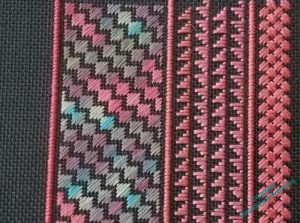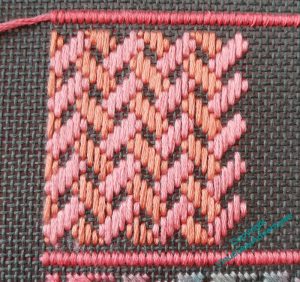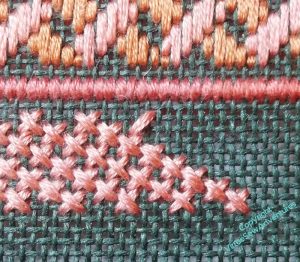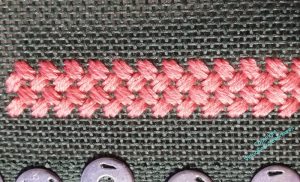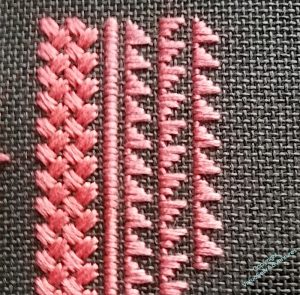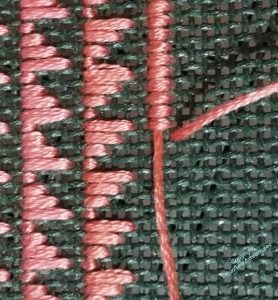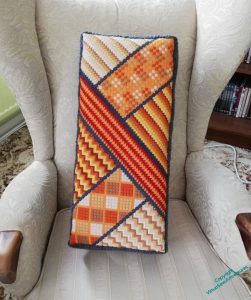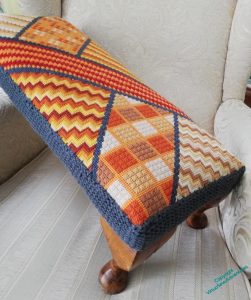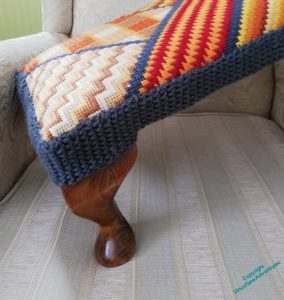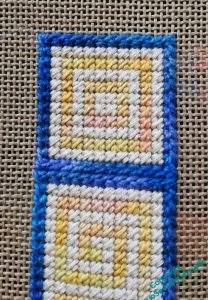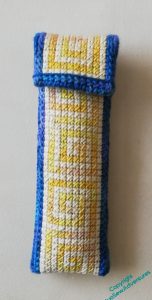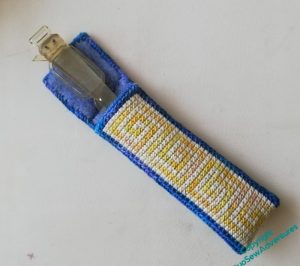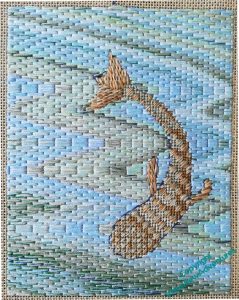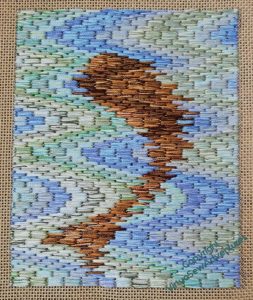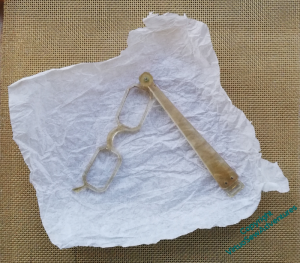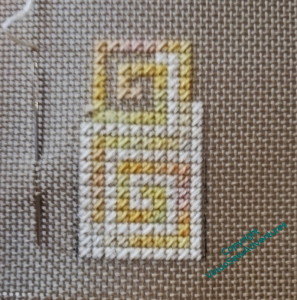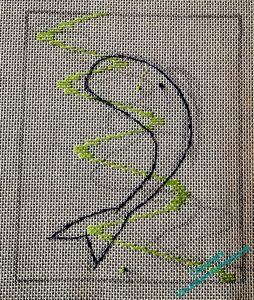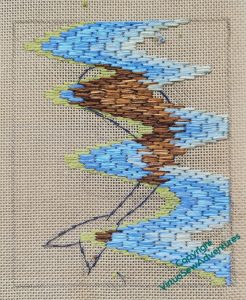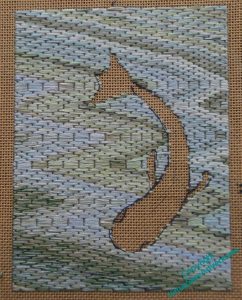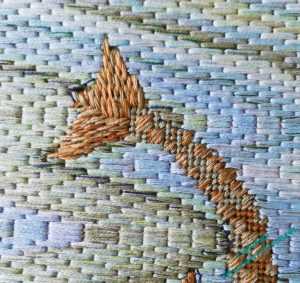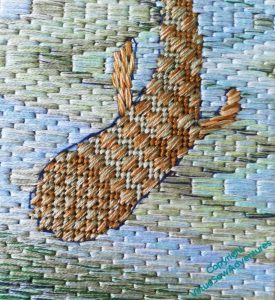Category: Needlepoint
Continuing the Exploration
The next panel, I decided, needed a little more variation in colour. The thread is a 12-strand overdyed stranded cotton from Stef Francis, and I’ve had it for so long (like the canvas) that I don’t know when I got it or what I had in mind for it at the time!
The stitch is Moorish Stitch, and again it is voided, leaving unstitched the row of tent stitches that alternate with the larger stitches under normal stitches.
I went back to Jo Ippolito Christensen for the next stitch, Medieval Mosaic Stitch, and with the alterations I made it looks most unexpected. As diagrammed, it is almost a variation on Florentine stitch, with a thick-and-thin ribbon of stitches running across the piece. In choosing the section to void, I picked the two small stitches that form the “thin” part, and as a result, that element has been completely obscured, and it looks like a classical woven pattern. That effect is enhanced by the fact that I picked two shades of coral to use up, hoping that they’d last to the end if they shared the burden. They did!
At this point, I think I have nearly enough stitched to make the sunglasses case I hope for, so I have mirrored the first section with another that leaves only one crossing-point voided. This is Staggered Crosses, and under normal circumstances there would be two different sizes of cross stitch contrasting with one another. I rather like this version, though!
Now I need to work out what form the glasses case will take, and what colour I’m going to back the canvas with, since it’s going to show…
Something that Wants Finishing..
Being known as a stitcher leaves one heir to everything stitch related that someone, far or near, may be at a loss to deal with. Sometimes this is a thrill, sometimes it’s a chore, sometimes a bewilderment.
I’m not sure what I’m going to do with this, passed on to me by a friend of a friend. Almost all you can see below is already finished, and I’m certainly not going to undo it.
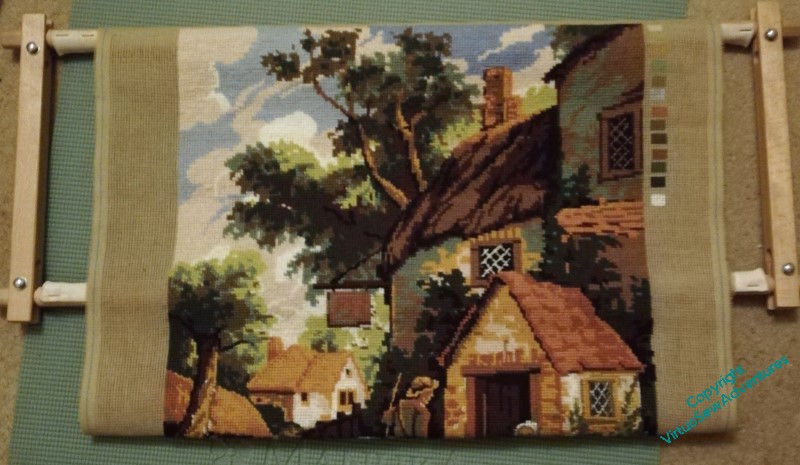
But what follows isn’t finished, and I don’t have the threads that came with the canvas.
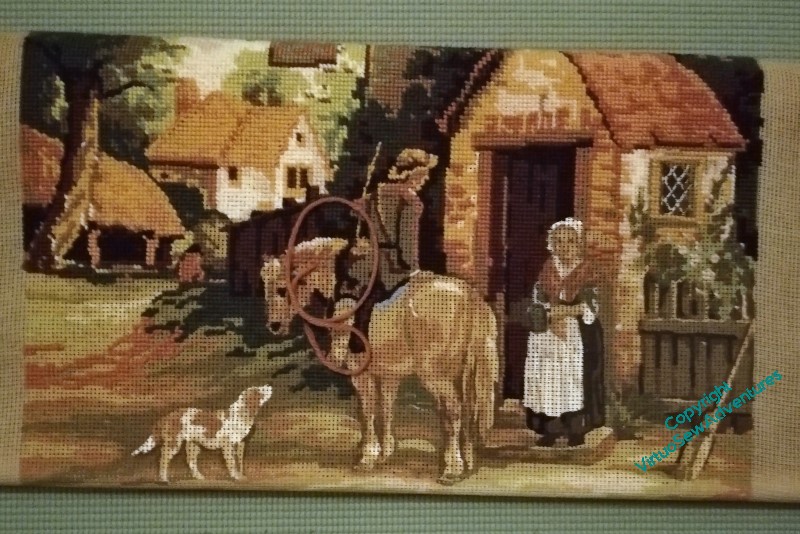
First thoughts are to unpick anything of the people and animals that’s been stitched, and restitch it with stranded cottons, maybe slightly more highly coloured. Then perhaps do the ground in a mixture of soft cottons and tapestry wool, although those muted, sludgy colours may be a little hard to find in my stash.
Thoughts, anyone?
An exploration
I’ve had this piece of forest green canvas for so long, I can’t remember where it came from, and since my instinct with canvas is always to cover it completely, I’ve been at rather a loss as to what to do with it. Then I realised that a rather nice pair of sunglasses lack a case, and decided to Explore.
The recent ebay purchase of the much-recommended “The Needlepoint Book” by Jo Ipplolito Christensen (which gave me the river below Tynemouth Priory) has given me a starting point. This is Criss Cross Hungarian Stitch, and the single crossing thread is intentionally left unstitched, which has given me my next theme: each section will involve leaving void some portion of the pattern. After all, that dark green makes a lovely foil for all the coral, doesn’t it!
The second block is named “Wild Goose Chase”, and there are a variety of ways I could have chosen to alternate stitching and voiding on this one. I think the one I chose in the end allows for a slightly smaller pattern block, and that, in turn, should protect the canvas. I am assuming that the stitch is named for, and inspired by, a quilting pattern.
I’m using a variety of elderly stranded cotton which came from a great aunt, so although I am going to try to keep to one shade per section, I’m not going to lose sleep over it if it becomes a bit of a hotchpotch!
Which is just as well, because the very next row ended up in a slightly darker shade of coral than the previous one!
I’m also separating each band of stitching with a row of satin stitch, but an effort to even out the different coverage of the various threads, it is satin stitch padded with an unseparated stranded cotton.
There’s something very pleasing about the coral against the green. I’m enjoying this!
Christmas Angel Finished

So here we are. All the gold canvaswork completed, the Angel outlined in different weights of thread, given tightly curled hair in French Knots, and now ready for however I work out how to mount her and turn her into something pleasing, and useful to decorate the house next Christmas.
I haven’t given the Angel a face, and I don’t think I will. It’s distressingly easy for “sweet” or “joyful” to become “disturbingly weird” with faces, especially when there is so little space, and relatively few stitches to manoevre with. If I experience an inspiration, I’ll reconsider, at least until I’ve mounted her. At the moment I’m looking for a sufficiently tall and wide cardboard tube that I can cut in half. Alternatively, I need to be very clever indeed about my card engineering…
It really only took as long as it did – it was begun in 2015 – largely because there was a lot of background, and it was remarkably tricky to find a rhythm to the pattern. Once I did so, it became much easier, and fairly romped away. Before that time, it spent a considerable period hidden away because – not having found the rhythm – it just made me grumpy to look at it!
Footstool finished and set up
There was something of a pause once I’d finished the cavaswork and we had removed the old cover from the little footstool. We reinstated all the padding (leaving my Grandad’s old pyjamas just where Grandmama had left them!) and stapled the cavaswork over the top.
However, that left a border of bare canvas, which was definitely not what I wanted on show, so there was some thought expended. There wasn’t enough of the assorted tapestry wools left over to make a border, and this was in progress during one of our lockdowns, so I couldn’t go frolicking off to a haberdashery to hunt for a braid. Very well, we would have to find a way of ensuring that our border matched, while trusting someone else to pick the material.
Fortunately, the threads I used were most of them current colours, and in particular the grey is a familiar Anchor colour. So it occurred to me that if I could find a shop that sold both embroidery supplies and knitting supplies, we could ask for a knitting wool to match the grey thread, and crochet a border.
That would have the advantage that we could be sure it would be wide enough to do the job, and in any case it could be slightly stretched to fit. I do like it when absolute millimetre precision isn’t necessary. This was a stash-busting, domestic area-improving project, not a major epic (although, you know, subject to my usual feature-creep!).
In the end, we picked a Tunisian Crochet stitch, and my Mam solemnly crocheted the necessary metre and a half of border, ten stitches wide, and then attached it.
No canvas showing now, and the knitting wool is such a perfect match you could be forgiven for thinking that we’d been intending this from the start!
Lorgnette Case Finished and Ready
The lorgnette case would have been finished more quickly had I not been using a corner of the same canvas I was doing the Fishy Experiments on!
When I’d bordered the scroll pattern, using a long armed cross stitch, I thought that maybe it wasn’t quite long enough, and added a square section to the top to act as a closing flap.
The next task was to cut it out, turn in the canvas and catch it down, and then line the piece with felt so that the interior doesn’t scratch the lenses of the lorgnettes. This is always rather fiddly, but a very necessary stage. I certainly wouldn’t want to try to add the felt without catching down the canvas separately!
The next thing was to turn the lined strip into the case. I’ve used the same variegated pearl cotton as I used for the border, and in effect, the same stitch. It goes forward two and back one, so the finished stitching creates much better coverage than a straight overcast stitch. It has a slight fishbone pattern, and you can continue on from the joining seam to run around the edge of the flap without even breaking stride, as it were.
Since there’s already colour variation in the yellow and the blue, minimising the textural variation by edging the flap with the same stitch as the case is closed with makes the whole thing pull together nicely.
It only took an afternoon or so to finish the case and install the lorgnettes, so they are now ready for those Happier Times I mentioned, when Museums and Menus are a regular part of life once more.
I should add that while I was at university, I was the girl who wore white gloves with her summer frocks. None of my friends will be at all surprised to find me wielding a pair of lorgnettes – in fact, if at least one of them doesn’t ask me what took so long, I will be rather surprised!
And now, the final (for now) episode of Slow TV Stitchery, Episode 73, in which the slips are at last applied, and Tynemouth Priory is Finished.
Fishy Lessons
So now, having finished my two fishie experiments (there may have been a third in the pipeline, but I’ve forgotten what it was!), what can I say I’ve learnt?
First, canvaswork stitches against the freeform bargello. There’s a sort of stillness, almost a static quality to this fish, in spite of the flowing bargello.
The bargello works well, although now I look at it, I’ve not managed to keep it flowing from top to bottom. And it was remarkably difficult to keep track of the pattern across the fish.
The second fish was an attempt to suggest the broken outline of an object seen through the interface between air and water. So this time, the pattern of the bargello ran through the fish, and I had to decide at each edge whether to stitch in the fish colour or the water colour. The pattern runs more successfully from top to bottom of the piece, but the whole thing looks a lot more active, maybe too active.
I think the colours are a bit too bright and swimming pool-like, but as these are experiments, using stash, I’m not too concerned about that. What does concern me is that even after these two, fairly substantial pieces, the appearance of a particular blend of threads as it was stitched was sometimes a surprise. It will be hard to pick the right colours to use if I can’t rely on my imagination of how the thread will stitch up.
So, I don’t know whether I will use this idea for the borders of Placidus, but I’ve got plenty to think about, haven’t I!
Episode 69 of Slow TV Stitchery is now live, on talking projects, the development of musical taste, and the challenges of suggesting wind over the water.
A nice, soft case for my lorgnettes
An old lady of my acquaintance once said to me, “Getting older is no fun, dear, but it’s better than the alternative”. Well, one of the effects of getting older – for me – is that I now need reading glasses. If I try to move while wearing my reading glasses, the results are sometimes disconcerting, sometimes positively disorientating.
I’d been wondering about what to do about this, until at the end of 2019, it occurred to me to channel my inner Lady Bracknell, and start wielding a pair of lorgnettes. I duly acquired some, with my usual impeccable timing (Ha!) at the beginning of March 2020.
Since then, of course, museums and menus have alike been out of reach, and I stowed the lorgnettes in my “Eve In The Garden of Eden” box in hopes of happier times to come. I’ve decided to get started on a case now, so as to be prepared for those happier times.
As I’m now dealing with the exhaustion consequent upon getting within sight of the finish on The Amarna Family Group (which has been going for nearly a year) and the Christmas Angel (begun around Christmas 2015!), I’ve been looking for small quick projects to reset myself, and this should be a good one.
This is a piece of 22 count cotton canvas I found lurking in my stash, and so far I think it will be very simple. I think six repetitions of the scroll will allow me to wrap the lorgnettes with a closing flap, and the light yellow (pearl cotton) and cream (stranded cotton) should make it eay to find in the depths of my handbag.
Episode 59 of SlowTV Stitchery is now live, in which we have almost recovered from the unpicking following last week’s stitching, and consider the particular delight of a fully-stitched fabric.
A Second Fishy Experiment
So, having learnt enough to be encouraged by the First Fishy Experiment, I embarked upon my Second Fishy Experiment.
Again, I drew out the borders, tacked the edges of the fish, and drafted the line of the bargello pattern using coloured sewing cotton. You can see how many times I thought and rethought what I was going to do in pencil beforehand!
I’m using the same bit of leftover canvas, so again my threads will be blended using nine strands of stranded cotton, although I’ve added a bit to the fish by using a variegated metallic machine embroidery thread as one of the strands.
This time the experiment is to see whether I can create something of the effect of looking through the surface of water at the fish. That means making the edges of the fish uneven, rather than crisp, so rather than an entirely different set of stitch choices for the fish, and compensation stitches everywhere, I will use the same stitch pattern throughout.
That in turn means that as I approach the edge of the fish on each row, I have a decision to make about whether to use the water colour or the fish colour for the stitch that straddles the edge. Fortunately, this isn’t the sort of decision I find unnerving or difficult to make, and even here, I think you can see that this idea is rather likely to work!
I realise that the post about starting the Second Fishy Experiment somehow managed to end up well behind the videos. Episode 57 of Slow TV Stitchery is now live, in which we muse on the effects of blending colours in the needle, the demise of Scottish pearling, and the final “It depends!” moment.
First Fishie Experiment Finished…
The background of freeform Bargello was rather entertaining to do. Working using nine strands of stranded cotton allowed for some subtlety in the colours, combining various blues and greens in different proportions and shading them into one another, sometimes gradually, sometimes stongly. I was surprised, sometimes, when progressively adding a particular colour, to find that it didn’t make as much difference as I expected – but this is why we experiment!
Once I came to the Fishie himself, there was a bit of puzzlement. I wanted to have a different pattern for the head, the fins and tail, and the body. I wanted a vaguely “scale-like” pattern, and I wanted to make sure that the stitches were at a different orientation to the water.
I settled on Moorish Stitch for the body, Mosaic Stitch for the head, and Encroaching Gobelins Stitch for the fins and tail. And I left in the tacked outlines. They only show in a few places, and I think they give the impression of sketched lines, which is quite suitable for an exploratory piece. I’ve also left out the eyes, since I’m looking from above.
Looking at it now, I’m pleased with the sense of flowing water that the bargello nearly creates, and the fish is interesting, but maybe not entirely successful. Some of the edges and joining points are a little clumsy – but that may be because this is an experiment, thrown together to see what I learn.
I’ve had at least one idea for another fishy experiment, so you will be seeing more of this sort of thing…
And indeed, Episode 54 of SlowTV Stitchery describes the beginning of the Second Fishy Experiment, in which I begin a second fishy experiment, this one attempting to give the impression of the fish seen through water, making some slight changes to the form of the freeform bargello, and anticipating tussles with my very leftoverish leftover thread.

